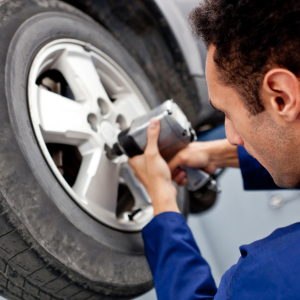Properly maintaining our vehicles is essential for safe and efficient transportation. One crucial aspect of car maintenance is ensuring the health of our tyres. However, even with the utmost care and caution, a punctured tyre can still happen unexpectedly. A tyre puncture not only poses a safety hazard, but it can also be costly and inconvenient. As such, it is crucial for car owners to know how to identify if their tyre is punctured and take necessary action before a simple issue turns into a major problem.
In this article, we will discuss the signs that indicate a punctured tyre, the potential causes of a punctured tyre, and the steps to take in case of a puncture. By understanding these crucial aspects, car owners can proactively detect and address a punctured tyre, ensuring the safety and longevity of their vehicle. Whether you are a new driver or an experienced one, the information provided in this article will equip you with the necessary knowledge and skills to identify a punctured tyre, allowing you to take immediate action and avoid any potential dangers on the road.
Inspect for visible damage

One crucial step in determining if a car tire is punctured is to inspect it for visible damage. This involves thoroughly examining the surface of the tire for any signs of cuts, tears, or bulges. Look for any exposed cords or wires, as these indicate significant damage that may compromise the integrity of the tire.
Additionally, check for any embedded objects such as nails or screws that may have caused the puncture. By carefully inspecting the tire for visible damage, you can quickly identify if a puncture is the cause of any potential tire issues, allowing for prompt and appropriate action to be taken.
Check for a flat tire

To ensure your safety on the road, it is important to regularly check for a flat tire. Start by visually inspecting the tire’s overall appearance, looking for any noticeable deflation or uneven wear. If the tire appears visibly lower or shows signs of bulging, it may indicate a flat or underinflated tire.
Additionally, pay attention to any unusual sounds such as thumping or flapping noises while driving, as these could also be signs of a flat tire. Finally, be mindful of any changes in the vehicle’s handling or steering responsiveness, as a flat tire can affect the overall stability and control of the car. Regularly checking for a flat tire can help prevent potential accidents and ensure a smooth and safe driving experience.
Listen for unusual noises
One important aspect of identifying a potential punctured car tyre is to listen for any unusual noises while driving. Pay close attention to any strange hissing or whistling sounds, as these could indicate a tire leak or puncture. Additionally, be on the lookout for any thumping or flapping noises, as these may suggest a flat or damaged tire.
Listening for these unusual noises can help you detect a punctured car tyre early on, allowing you to take prompt action and prevent further damage or potential hazards on the road. By being attentive to the sounds your car makes, you can ensure your safety and the proper maintenance of your vehicle.
Feel for a loss of pressure
While it is essential to listen for unusual noises, another effective method to identify a potential punctured car tyre is to feel for a loss of pressure. Regularly checking the tire pressure can help detect subtle changes that may indicate a puncture. Start by gently running your hand over the surface of each tire, paying attention to any areas that feel softer or deflated compared to the others.
If you notice a significant difference in pressure, it could be a sign of a puncture. Additionally, while driving, if you feel a noticeable change in the handling or stability of your vehicle, it may indicate a punctured tyre. These physical sensations can serve as valuable indicators to determine if your car tyre is punctured.
Monitor for steering difficulties

To ensure your safety on the road and identify potential steering difficulties, it is crucial to monitor the overall performance of your vehicle. While steering difficulties can be caused by various factors, it is essential to pay attention to any changes in how your car handles. If you notice that your vehicle pulls to one side while driving or requires excessive effort to turn the steering wheel, it could be an indication of steering difficulties.
Additionally, if you experience vibrations or shaking in the steering wheel, it is advisable to have your car inspected by a professional. By monitoring and promptly addressing any steering issues, you can maintain optimal control of your vehicle and reduce the risk of accidents or tire-related problems. Remember, regular maintenance and attentive monitoring are key to ensuring the safety and functionality of your vehicle.
FAQs About car tyre is punctured
What are the common signs or symptoms that indicate a car tire is punctured?
Common signs or symptoms of a punctured car tire include a sudden loss of air pressure, a noticeable decrease in handling or steering control, a vibrating or shaking sensation while driving, a loud thumping or flapping noise, and visible damage such as nails or debris lodged in the tire.
Are there any specific sounds or noises that can help identify a punctured tire?
Yes, there are specific sounds that can help identify a punctured tire. A common noise is a hissing sound, which occurs when air escapes from the puncture. This sound is often accompanied by a decrease in tire pressure, causing the tire to feel flat or soft. Additionally, if the puncture is severe, you may hear a loud bang or pop when the tire bursts. It is important to listen for these sounds and inspect your tires regularly to ensure they are in good condition and to prevent potential accidents or damage.
How can I visually inspect my car tires to determine if there is a puncture?
To visually inspect your car tires for punctures, start by checking for any visible objects like nails or screws embedded in the tread. Look for any irregularities in the tire’s shape, such as bulges or deformities, which could indicate a puncture. Also, inspect the sidewalls for cuts, tears, or any signs of damage. Additionally, pay attention to any loss of tire pressure, as it could be a sign of a slow leak caused by a puncture. If you suspect a puncture, it is recommended to have a professional mechanic or tire specialist further examine the tire to ensure safety.
Final Words
It is important to regularly check for signs of a punctured car tyre to ensure safe driving and avoid potential accidents. By following the steps outlined in this post, you can properly identify a puncture and take the necessary steps to repair or replace the tyre. Remember, proper maintenance and regular checks are key to ensuring the longevity and safety of your vehicle. Don’t ignore any signs of a puncture, as it could lead to more serious issues down the road. Stay vigilant and keep your car and yourself safe on the road.

